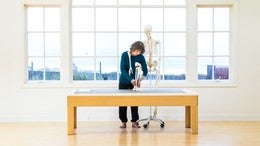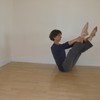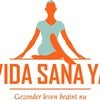Description
About This Video
Transcript
Read Full Transcript
Thanks for joining me. We're now at the stage of having explored your feet to the nth degree. We're now going to just take your feet and put them into full body movement, and apply it to what might look a little bit more like what we do regularly in Pilates. So start lying on your back. Bring your knees to your chest, and just start rocking, massaging your back into the floor, waking up your sacrum.
You can rock your knees into your chest and get some pumping through your spine. It's like a mini heel rock. This always feels so good to me. I could do it all day. But, we won't.
We'll move on. So drop your hands, and just kick, easy kick. Shake out your feet. And then up to the ceiling and jiggle, and really shake your feet. Just, just, blub blub blub blub blub blub.
Get your calves jiggling side to side and your ankles. Full release, feeling your femurs dropping down into your sockets. This should automatically turn on your abs, but in a gentle way. And then kick your hamstrings. If your knees allow to bend this much, it's really cool to get the force into your feet, and the force into your hamstrings, actually.
In my anatomy, my heels hit in front of my sitz bones. You don't want your heels hitting your sitz bones directly. So that depends on how you're built I suppose. But I can get a little jiggle through the bones of my feet by doing that. And then back up to the ceiling.
And jiggle, and let all the blood drain out of your feet because sometimes it takes awhile for your feet to understand that they're not supporting you. That they can rest in the air. And then drop your feet down. Walk your feet to the side. Get your arms outta the way.
And you can get a nice pelvic, like a tail wag. Not exactly a wag, but a side to side through your sacrum. Plus it's just fun. And come back into center. From here, creepy crawlies.
Bird feet, all the way out. Into full heel extension. Bring your arms overhead. Reach long through your feet, and then, if you're on a mat, you can't. If you're on the floor you can slide, but if you're on a mat, you just have to place your feet back up and your arms down.
And again, bird feet forward until you can't go anymore, and then slide the back of your leg into your heel. Arms overhead, get a nice long stretch, whatever feels good. Ooh, that feels good. And then, if you can, slide your arms and slide your feet or walk your feet back down. One more time.
Go out. Stay out, flex. And, you can always sneak in a little extras, and then, coming back in. From here, slide your right leg out. This is the deluxe arm circles.
Bring up your right knee. Did I say right? Slide your left leg out. Let's make sure I'm on the mat. And circle both ankles so that your body knows where your southern extended edge, the edge of your, it's like the California edge.
Outside of your foot is literally here is the Pacific Ocean. And your proximal. So distal and proximal. And circle the other way. So not just your top foot, but both feet will give your body information.
And then you can, I'm in love with bird feet these days. It just feels so good on me, so I tend to stick it in. But you can, anything here. Separate your toes, just get your feet moving so that they become awake. And again, your feet are the edge of you.
The frontier, your boundary, your border to the air outside of you. It's what defines what's your body and what's not. And so, it's important to have them awake. Open your leg to your open side, hand on your opposite hip so you feel your femur dropping down into your socket. This is the placement that you would want for your leg to be out to the side for leg circles or anything else.
But just open your hip socket. Switch hands. Right arm goes out to the side. Left hand carries your knee across your body. And you can stay there.
Look back at your hand. Get a nice spiral twist. And then, the deluxe arm circles. You roll back. It's really important that your shoulder blade is still on the floor so that your arm is not hanging off the ligaments.
When you go forward, let your knee slide forward so you get this nice stretch across your sacrum. So there's a fair, it's almost like a baby roll. Forward. Really limp and loose. And you can do lots of these, but for right now I'll reverse direction.
My general rule of thumb for how many to do when you're doing soft movement like this is do as many as your body wants. And when you've had enough, you'll get bored. Your attention will start to go somewhere else. And that's when you know you're done. Good.
From here, your arm goes to your upper diagonal. Leg lengthens out. Flex your foot, and find the diagonal from that heel to your hand. And you can rock a little bit with your heel on the ground. Again, this is a amazing full body spiral through your spine.
You can get a lot of intestinal and psoas length through here. And then slide back to center with your leg long. And take a moment. Notice what this feels like. I don't know if you can see it on me, but it feels like this leg is a good two inches longer.
And then begin with your left. So you bring up your left leg, start with your feet. Sometimes I start with my left because very often the left side gets left out. We always do it second. If you're right dominant, you'll start with your right side.
And it's a really good idea to switch that every once in awhile. So circling in your ankles, and bird feeting and wiggling your toes, and anything that helps to wake up. Relaxing your shoulders. (laughs) Ruth, drop your shoulders. And then take your leg to your open side.
Find the place where your femur's dropping down into your socket and your pelvis is nicely anchored. Just this by itself feels like a really grounding experience. Switch hands. Left arm goes out to the side. Right knee across.
This is my mishegas side. It's my funky side, so I'm tighter here. I personally don't like having my foot back this way. I like my foot on the floor. It opens, puts less pressure on my knee.
And when you go into your arm circles, it allows for movement of your whole body. I'm just gonna adjust, I'm rolling off my mat. And at least three of them, but they're days when I need to do 10 of 'em before I feel like anything's opening up. But for today we'll do three. And then reverse direction.
Feet right now are just resting. They're not doing anything in particular, although I do know that they're there. It's 10:00, do you know where your feet are? That's a joke. There used to be a commercial at 10:00, right before the 10:00 news.
It's 10:00, do you know where your children are? So your arm is out to your side. Extend your leg long on the diagonal, flex your ankle, find the opposite arm, whatever that, if you can feel the diagonal. It doesn't have to be exact. And you can sorta rock through it a little bit, feeling this extension through here.
And then roll back to center with your legs straight. Readjust on the mat, and go right into a heel rock. And this mat is very sticky, so man, my heel rocks can go really big. I once taught in a summer camp, and a 12-year-old said this was like rowing a boat with your feet. And I always liked that description.
You can go small, make it really small and fast. Goes all the way up to my head. Or you can make it really big. You can do the heel rocks on diagonals, one heel into the opposite hand. And boy you'll find out a lot.
You can see this side is all screwed up and goes every which way but straight. And this side is much more direct right into my hand. Alright. From here, let's do a roll up. Arms up.
So, this is interesting for this part. Play with flexing your feet first. And coming up. And rolling back down. And now point your feet.
Or Barbie feet. And now try it bird feet. That's peculiar. So what you do, and now, the last one is don't use your feet at all. (laughs) I can't even get up.
Oh my goodness. If I let go of my feet, and they're dead fish hanging off my ends of my legs, then my whole leg doesn't connect. The back of my leg doesn't connect. And I had to, let's try that one again. So dead feet.
Look how much I have to do here. As opposed to there. So that's, that's a really key point. Okay, so, the next thing we're gonna do, I forgot to tell you at the beginning, is to go get a foam roller. So, if you need to take a break, put it on pause and go get your foam roller.
Mine is right here. So, the best way, the safest way to get into this is to lie down, put the roller under your legs, and then lift up. Hold the sides of the roller. Bring your legs up. And here, two things.
You can see your feet, which is handy. And they're also in the air, so there's no pressure on them. And again, you can, because we've already worked your feet and some other things, let's do the E version. This is really important, for, especially for women, but I think for everybody. We're all over stretched this way.
Right, because either you sprained it, or because that's just, we're just looser that way. It's really important to go from parallel to contracting this side of your foot, the outside of your foot. Even if it's a tiny movement. Don't go in and to parallel. Lot of people will go in and just go to parallel, but it's better to go parallel, out, parallel, out.
So you wanna contract the whole line of what used to be called the peroneal muscle. And now it's called the fibularis, which I think is coming down in the world. But, anyway, it's now called the fibularis. Good. We're gonna do leg lowers, so flex down and point up.
Flex down, and point up. Flex down, and point up. Flex down, point up. Scissors. Flex, pointing.
So your point is literally leading your leg. Right, it's leading your leg where it's going in space, and your flex is gonna further stretch your hamstrings. You could reverse it. Point, (laughs) Ooh, no I can't. Okay, you can reverse it.
I'm just so habitually trained into this now. You can turn this into bicycles. Again, sending the energy out through your feet sends the energy out of your hip sockets, out of your quads. You can backpedal. And you can come up.
Another good thing to do here is rotate, and parallel. Rotate. Really isolating the movement to your trochanters, and therefore the rotators under your gluts. And then from there you can go into full circles. Try circles with bird feet.
Try circles with Barbie feet. Try circles, we'll reverse it pointing. Except my left foot doesn't want to point, it's cramping. And I, don't ask me why, what causes cramping. I'm still trying to find out.
Uh, frogs. Flexing. We generally do frogs flexing very often. It's the built-in choreography. You can do frogs this way.
Using your feet as what makes the movement happen almost, the articulation of it. And then just relax. Shake out your feet. It's actually quite a workout for your feet. You can do the leg pattern from short spine.
Very often, I'll do this for people who are not, where it's inappropriate. 'Cause they have neck issues, you don't want them to do a full short spine. Or they have back issues. And just doing the leg pattern of it can be useful. Okay.
So, bring your feet down. There's lots more you can do here. You can just go to town and play with your legs and your feet. Push the foam roller out. And push it to the side.
So single leg stretch is next. Assume the position. What I see a lot is, when people's feet are dead, you get this thing where the leg has no focus. So if you point your feet or flex or bird feet. Not bird feet, but Barbie feet would work, too.
You wanna reach for where you're going. I'm gonna flex. Right, reach. If your foot starts cramping, flexing can help. Right, your foot is what's leading the single leg stretch.
Same with double leg stretch, right? Your feet are leading. And your fingers. So feet and fingers will help take the pressure, distribute the pressure evenly. Alright, we're gonna roll over for swan.
So, on your bellies, feet up underneath, and windshield wipers. This actually, I think, originally came from the Feldenkrais world. But just a little bit of a release in your gluts and your low back, and a bit of a spiral. Drop your legs down. Place your elbows as far down as you can.
Roll a marble with your nose. And come up. And notice what your feet do, right? Your, by default, by the nature of the position, the top of your foot is stretching. So, the brilliance of Pilates, right?
You don't think of this with your feet. Almost everybody's paying so much attention to their upper body, but this position for your foot is stretching this part of your foot. It's built-in. So actually use it. Make something of it.
Right, you come up into your swan, and if you reach through your feet. And I'm gonna do it now once with no feet. Try this on your own. If I deaden my feet, I deaden my abs. Everything is collapsed.
If I reach through my feet, the whole thing connects. Bring your roller back in. And a little foot work. This, if this doesn't work for your knees, basically just don't do it. You know, if your knees can't bend this much, there's not really a substitute way to do it.
You could do it standing up, holding onto a wall or a support. But I'm rolling forward onto the ball of my feet and back. So this is stretching the sole of my foot, which is great for, I think it's the main exercise they give you to do for plantar fascitiis, I think. I just know I need it a lot. It gets very stiff, especially first thing in the morning.
And then, you can roll forward. And stretch again, stretch the top of your foot. If it's too painful, you just come out of it. You go back into it. You come out of it.
Come back into it. So you never ask your body. You never make it a confrontation. You want to get to the point, on me, it's the ooh, it hurts so good feeling. Yes, it's tight, and I can feel it, but there's no alarm bells going off.
But if your nervous system just can't handle it, don't handle it. Just, you know, you can do it from here. Oh, that's pretty cool. Ha, just made up a new one. Right, you can do different things.
Come back into your squat with your hands on your roller. And let's drop your heels down. If you can straighten your knees, great. If you wanna keep your knees bent, that's okay, too. Releasing your lower back, and coming back down.
The handy thing about the roller is it gives you just enough support off the floor, so if your hamstrings are tight you don't have to, you know, get all the way down. The other thing that it can do is, as we talked about in the first tutorial, you can rock forward, rock your, in this case, your foot is very stable, and you can rock your sitz bones forward and back, changing the angle at your ankle, but keeping your heels really grounded. This is a really good prep for what becomes the pushup. Right? You have, this is, excuse me.
There we go. In the pushup, the Pilates pushup, that's what you need to do. Right, you need to have that dexterity in your ankle. So you get to your plank. Where's my head?
Where's my belly? Bend your elbows. And push back into your heels. And then, use your hamstrings to pull you back, not your hands, right? Walking out, you're still in your heels, in both heels, which will help prevent waddling.
And, in this case, I'm really releasing the front of my ankle. I come into. I don't. I walk out one more step. I come into my alignment.
I do my pushup. And I come back into my heels without side to side. If, you can do this yourself at home. If you push from one hand to the other, you end up side, side swinging. But if you do it from your feet, right?
Feet, and I shouldn't say just feet. It's feet and sitz bones. Boink. Right, it's your heels and your sitz bones. And there you are.
You can't walk around like this all day, so let's just roll up because we are bipedal, and you do have to stand up to walk home. Thank you very much.
Comments
 Thank you
Thank you
You need to be a subscriber to post a comment.
Please Log In or Create an Account to start your free trial.





























